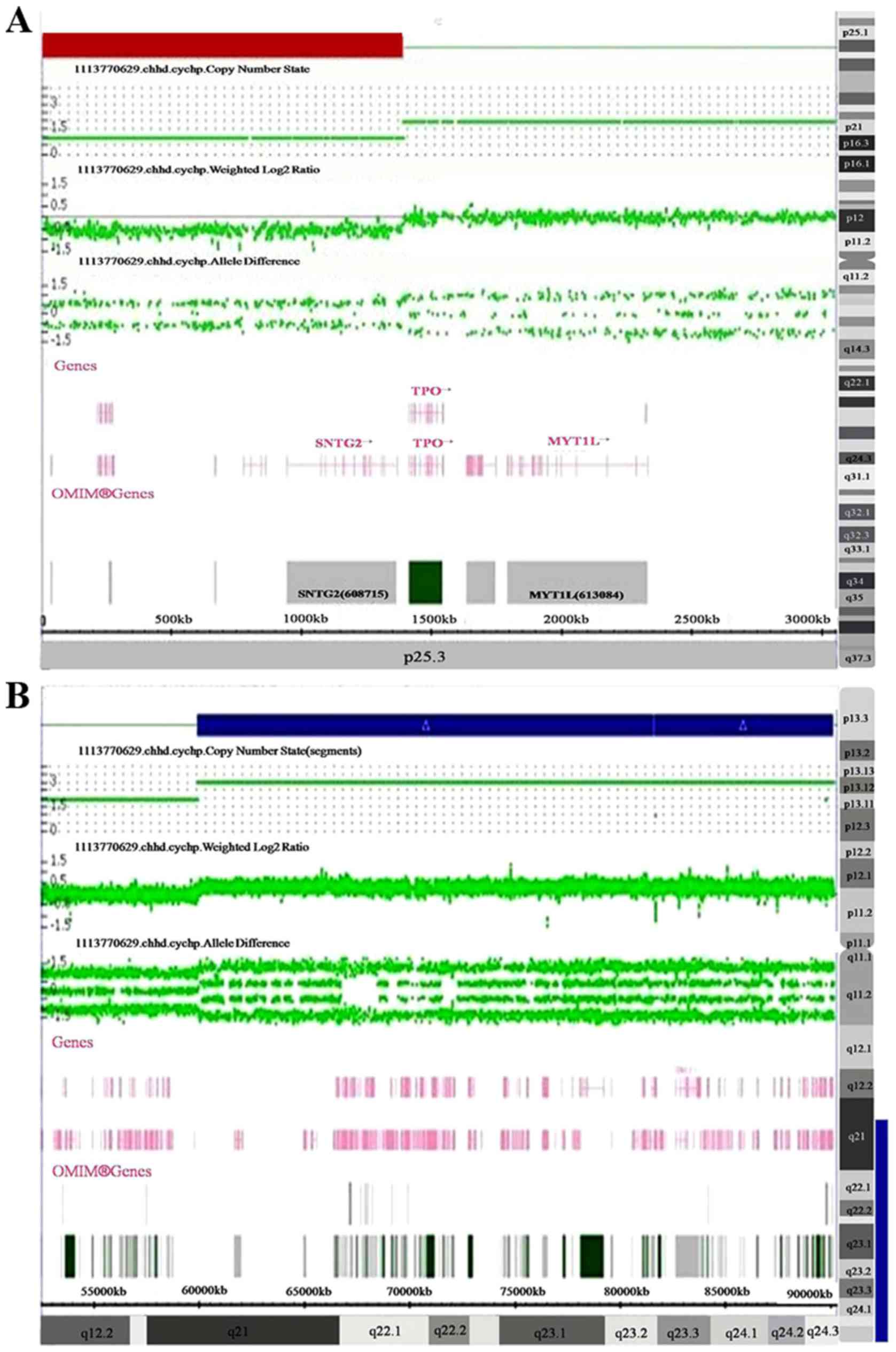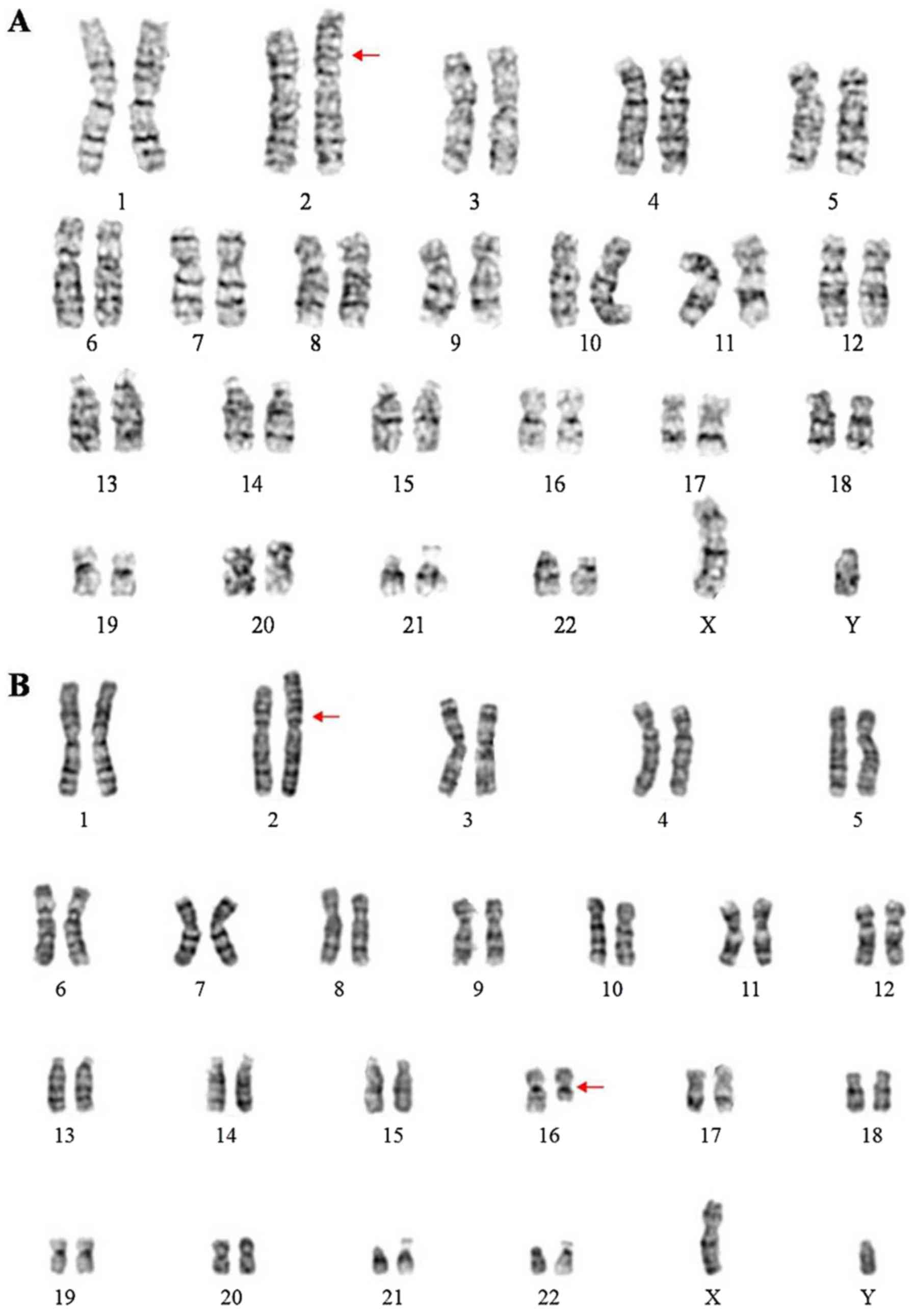|
1
|
Brisset S, Joly G, Ozilou C, Lapierre JM,
Gosset P, LeLorc'h M, Raoul O, Turleau C, Vekemans M and Romana SP:
Molecular characterization of partial trisomy 16q24.1-qter:
Clinical report and review of the literature. Am J Med Genet.
113:339–345. 2002. View Article : Google Scholar : PubMed/NCBI
|
|
2
|
Hassold T, Merrill M, Adkins K, Freeman S
and Sherman S: Recombination and maternal age-dependent
nondisjunction: Molecular studies of trisomy 16. Am J Hum Genet.
57:867–874. 1995.PubMed/NCBI
|
|
3
|
Maher ER, Willatt L, Cuthbert G, Chapman C
and Hodgson SV: Three cases of 16q duplication. J Med Genet.
28:801–802. 1991. View Article : Google Scholar : PubMed/NCBI
|
|
4
|
Schmickel R, Poznanski A and Himebaugh J:
16q trisomy in a family with a balanced 15/16 translocation. Birth
Defects Orig Artic Ser. 11:229–236. 1975.PubMed/NCBI
|
|
5
|
Laus AC, Baratela WA, Laureano LA, Santos
SA, Huber J, Ramos ES, Rebelo CC, Squire JA and Martelli L:
Karyotype/phenotype correlation in partial trisomies of the long
arm of chromosome 16: Case report and review of literature. Am J
Med Genet A 158A. 821–827. 2012. View Article : Google Scholar
|
|
6
|
De Rocker N, Vergult S, Koolen D, Jacobs
E, Hoischen A, Zeesman S, Bang B, Béna F, Bockaert N, Bongers EM,
et al: Refinement of the critical 2p25.3 deletion region: The role
of MYT1L in intellectual disability and obesity. Genet Med.
17:460–466. 2015. View Article : Google Scholar : PubMed/NCBI
|
|
7
|
Doco-Fenzy M, Leroy C, Schneider A, Petit
F, Delrue MA, Andrieux J, Perrin-Sabourin L, Landais E, Aboura A,
Puechberty J, et al: Early-onset obesity and paternal 2pter
deletion encompassing the ACP1, TMEM18, and MYT1L genes. Eur J Hum
Genet. 22:471–479. 2014. View Article : Google Scholar : PubMed/NCBI
|
|
8
|
Stevens SJ, van Ravenswaaij-Arts CM,
Janssen JW, Klein Wassink-Ruiter JS, van Essen AJ, Dijkhuizen T,
van Rheenen J, Heuts-Vijgen R, Stegmann AP, Smeets EE and Engelen
JJ: MYT1L is a candidate gene for intellectual disability in
patients with 2p25.3 (2pter) deletions. Am J Med Genet A 155A.
2739–2745. 2011. View Article : Google Scholar
|
|
9
|
Wu XL, Li R, Fu F, Pan M, Han J, Yang X,
Zhang YL, Li FT and Liao C: Chromosome microarray analysis in the
investigation of children with congenital heart disease. BMC
Pediatr. 17:1172017. View Article : Google Scholar : PubMed/NCBI
|
|
10
|
Shaffer LG, Slovak ML and Campbell LJ:
ISCN 2013: An international system for human cytogenetic
nomenclature. Basel, Switzerland: Karger S.; pp. 1382013,
PubMed/NCBI
|
|
11
|
Barber JC, Zhang S, Friend N, Collins AL,
Maloney VK, Hastings R, Farren B, Barnicoat A, Polityko AD,
Rumyantseva NV, et al: Duplications of proximal 16q flanked by
heterochromatin are not euchromatic variants and show no evidence
of heterochromatic position effect. Cytogenet Genome Res.
114:351–358. 2006. View Article : Google Scholar : PubMed/NCBI
|
|
12
|
Balestrazzi P, Giovannelli G, Landucci
Rubini L and Dallapiccola B: Partial trisomy 16q resulting from
maternal translocation. Hum Genet. 49:229–235. 1979.PubMed/NCBI
|
|
13
|
Garau A, Crisponi G, Peretti D, Peretti D,
Vanni R and Zuffardi O: Trisomy 16q21=to qter. Hum Genet.
53:165–167. 1980. View Article : Google Scholar : PubMed/NCBI
|
|
14
|
Lessick ML, Israel J, Wong PW and Szego K:
Partialtrisomy 16q secondary to a maternal 9;16 translocation. J
Med Genet. 26:63–64. 1989. View Article : Google Scholar : PubMed/NCBI
|
|
15
|
de Carvalho AF, da Silva Bellucco FT, dos
Santos NP, Pellegrino R, de Azevedo Moreira LM, Toralles MB,
Kulikowski LD and Melaragno MI: Trisomy 16q21→qter: Seven-year
follow-up of a girl with unusually long survival. Am J Med Genet A
152A. 2074–2078. 2010. View Article : Google Scholar
|
|
16
|
Mishra R, Paththinige CS, Sirisena ND,
Nanayakkara S, Kariyawasam UGIU and Dissanayake VHW: Partial
trisomy 16q21→qter due to an unbalanced segregation of a maternally
inherited balanced translocation 46,XX,t(15;16)(p13;q21): A case
report and review of literature. BMC Pediatr. 18:42018. View Article : Google Scholar : PubMed/NCBI
|
|
17
|
Zou YS, Van Dyke DL and Ellison JW:
Microarray comparative genomic hybridization and FISH studies of an
unbalanced cryptic telomeric 2p deletion/16q duplication in a
patient with mental retardation and behavioral problems. Am J Med
Genet A 143A. 746–751. 2007. View Article : Google Scholar
|
|
18
|
Wohlschlegel JA, Dwyer BT, Dhar SK, Cvetic
C, Walter JC and Dutta A: Inhibition of eukaryotic DNA replication
by geminin binding to Cdt1. Science. 290:2309–2312. 2000.
View Article : Google Scholar : PubMed/NCBI
|
|
19
|
de Munnik SA, Bicknell LS, Aftimos S,
Al-Aama JY, van Bever Y, Bober MB, Clayton-Smith J, Edrees AY,
Feingold M, Fryer A, et al: Meier-Gorlin syndrome
genotype-phenotype studies: 35 individuals with pre-replication
complex gene mutations and 10 without molecular diagnosis. Eur J
Hum Genet. 20:598–606. 2012. View Article : Google Scholar : PubMed/NCBI
|
|
20
|
Zhang A, Yeung PL, Li CW, Tsai SC, Dinh
GK, Wu X, Li H and Chen JD: Identification of a novel family of
ankyrin repeats containing cofactors for p160 nuclear receptor
coactivators. J Biol Chem. 279:33799–33805. 2004. View Article : Google Scholar : PubMed/NCBI
|
|
21
|
Sirmaci A, Spiliopoulos M, Brancati F,
Powell E, Duman D, Abrams A, Bademci G, Agolini E, Guo S, Konuk B,
et al: Mutations in ANKRD11 cause KBG syndrome, characterized by
intellectual disability, skeletal malformations, and macrodontia.
Am J Hum Genet. 89:289–294. 2011. View Article : Google Scholar : PubMed/NCBI
|
|
22
|
Kleyner R, Malcolmson J, Tegay D, Ward K,
Maughan A, Maughan G, Nelson L, Wang K, Robison R and Lyon GJ: KBG
syndrome involving a single-nucleotide duplication in ANKRD11. Cold
Spring Harb Mol Case Stud. 2:a0011312016. View Article : Google Scholar : PubMed/NCBI
|
















